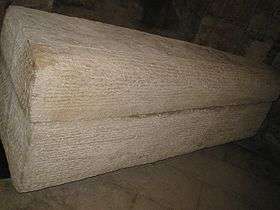Aregund


Aregund, Aregunda, Arnegund, Aregonda, or Arnegonda (c. 515/520–580) was a Frankish queen, the wife of Clotaire I, king of the Franks, and the mother of Chilperic I of Neustria. She was the sister of Ingund, one of Clotaire's other wives. Ingund and Aregund were the daughters of Baderic, King of Thuringia.
It is said that Ingund was quite alarmed at her sister staying single and asked her husband Clotaire to find Aregund a husband. After meeting his sister-in-law, Clotaire is rumoured to have announced to his wife that he had found her a suitable husband- himself. While Ingund bore 5 sons and one daughter, Aregund bore only one son.
The study of Aregund's skeleton suggests she had a child when she was aged about 18. However, in Frankish society at the time, girls generally married around the age of 15. Aregund likely had a limp as osteo-archaeology has shown that she suffered from poliomyelitis at a young age. Clotaire may have married his sister-in-law out of pity, as she was not deemed marriageable due to her lameness. Alternatively, as the death rate from childbirth was high, Aregund may have succeeded her sister to foster her orphaned nephews and nieces. Ingund died between 538 and 546 AD.
In 538, Clotaire married Radegund of Thuringia.
Aregund and Radegund both survived their marriage to Clotaire. Radegund became a Saint, whilst Aregund became the great-grandmother of the last of the Merovingian kings to wield power, Dagobert I.
What was believed to be Aregund's sarcophagus was discovered, among dozens of others, in 1959 in the Saint Denis Basilica by archaeologist Michel Fleury. It contained remarkably well-preserved clothing items and jewellery. However subsequent research throws doubt on the identification.[1]
In an episode of the television series, Digging for the Truth, aired in May 2006, host Josh Bernstein arranged a DNA test of a sample of her remains to see if it showed any Middle Eastern characteristics. It did not. This was meant to disprove the notion put forwards by the Da Vinci Code that the Merovingians were descended from Jesus, though Aregund was merely married into the dynasty, not a blood descendant- so the results of this test are entirely irrelevant.
References
- ↑ Noble, Thomas F. X. From Roman Provinces to Medieval Kingdoms. Routledge, 2006. p. 159
| Wikimedia Commons has media related to Arégonde. |
- Erlande-Brandenburg, Alain, "Saint-Denis Cathedral", Editions Quest-France, Rennes, n.d.
Gregory of Tours, History of the Franks http://www.fordham.edu/halsall/basis/gregory-hist.asp Wemple, Suzanne Fonay, Women in Frankish Society: Marriage and the Cloister, 500 to 900, University of Pennsylvania Press, 1985